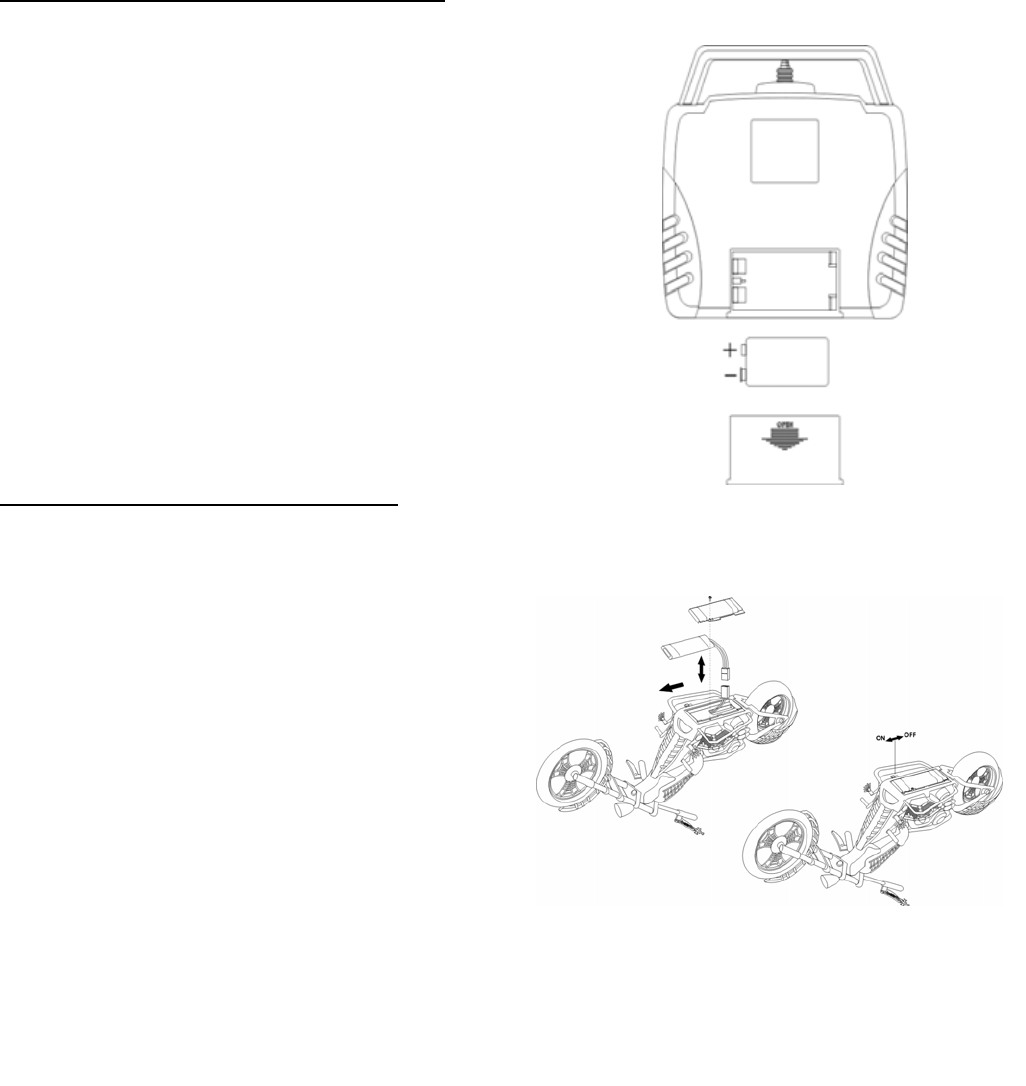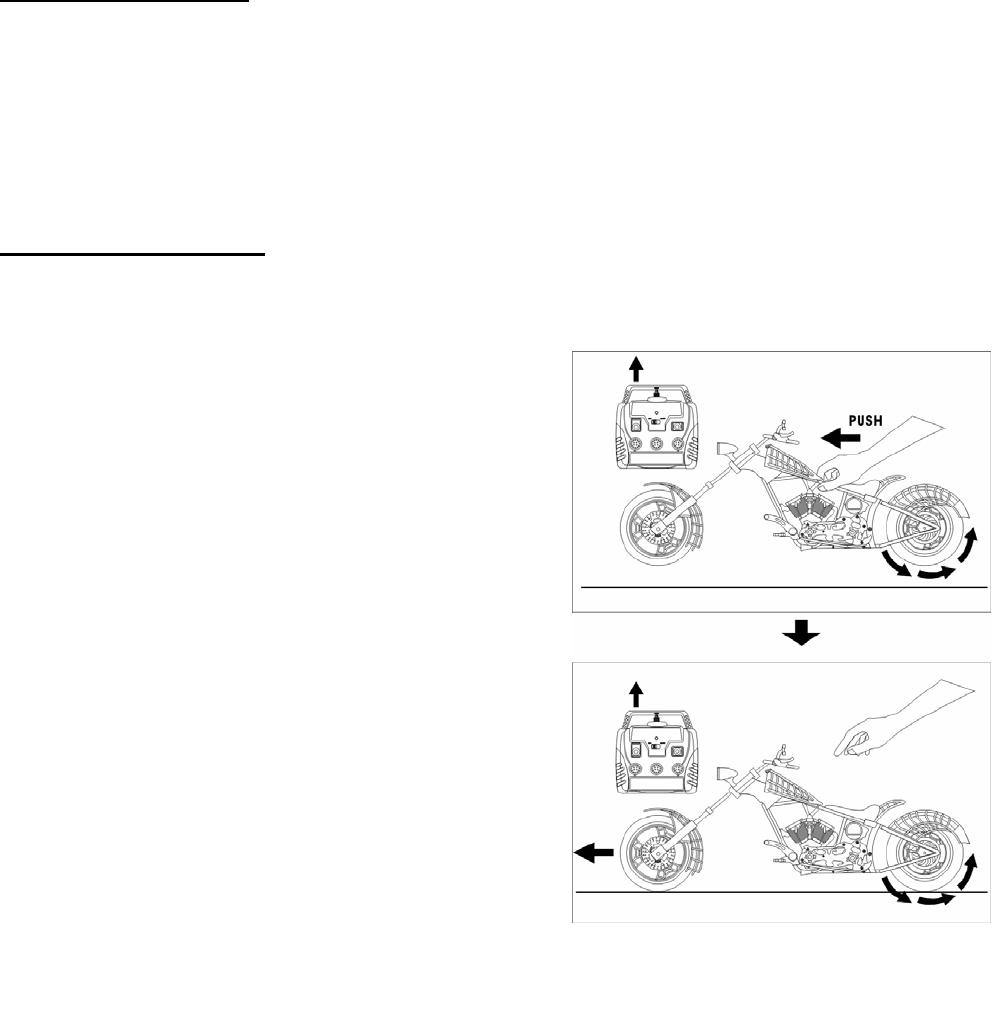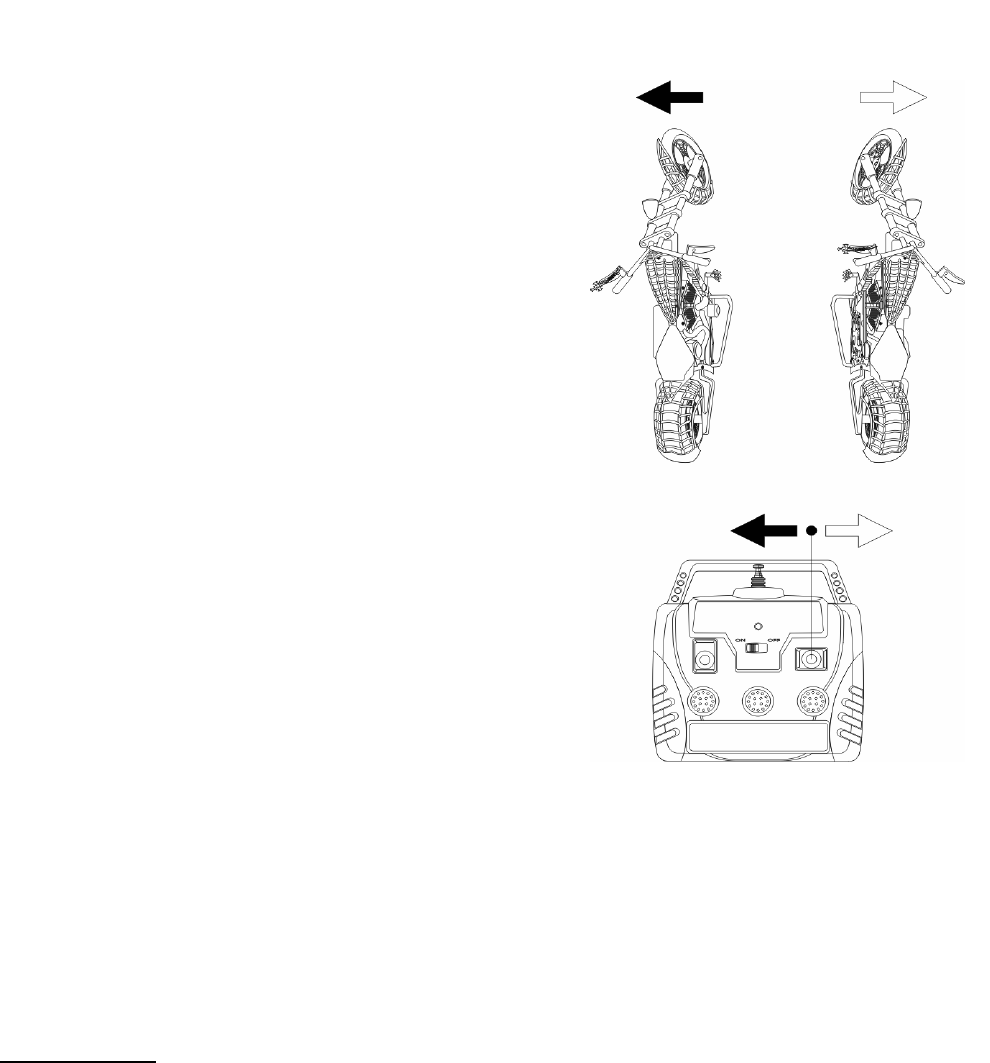TOYS R US 231449 49.82-49.90MHz WIRELESS R/C TOY-RX User Manual
TOYS "R" US 49.82-49.90MHz WIRELESS R/C TOY-RX
USERS MANUAL

Owner’s Manual – 2314
Read Owner’s Manual carefully and completely before operating the Motorcycle.
Battery Requirement: : One (1) 9V battery for transmitter
One (1) 7.2V battery pack for Motorcycle
Installing the Battery in the Transmitter
1. Slide the battery compartment cover in the direction
of the arrow on the cover to remove it.
2. Install the 9V battery in the compartment in
accordance to the polarity symbols (+ and -)
marked inside.
3. Replace the cover and snap it shut.
Note: When the range of transmitter decreases,
replace with a new battery.
Installing Battery in the Motorcycle
1. Turn the ON/OFF switch on the side of
the Motorcycle to OFF.
2. Loosen the screw on the battery
compartment cover located on the
bottom of the motorcycle and remove the
cover.
3. Install the 7.2V battery pack in the
compartment. Make sure the battery
pack in fully charged before use. Attach
the battery pack’s white plastic connector
to the motorcycle’s matching connector.
Do not force them together. They only
fit one way.
4. Replace the cover and secure it with the
screw.

Installing the Antenna
1. Route the loose end of the motorcycle’s antenna wire through the supplied antenna
tube.
2. Insert the tube securely into the motorcycle’s tube holder.
Driving The Motorcycle
1. Extend the transmitter’s antenna to its full
length before driving the motorcycle. For
maximum range, hold the transmitter with the
antenna as high as possible and point it
straight up.
2. Turn the Motorcycle and Transmitter’s
ON/OFF switch to ON. The LED indicator on
the transmitter illuminates.
3. Hold the front of the seat and lift the rear wheel
of the Motorcycle off the ground.
4. Push the Left Control Lever on Transmitter
forward for about 5 seconds to conducts a
warm up drive of the Motorcycle rear wheel.
5. Release the motorcycle on floor and start
driving. Be sure to run in a large open area
as the unit requires more space to make a full
turn than most radio controlled vehicles.

6. Use the Transmitter’s control levers to drive
and steer your Motorcycle as follows:
▪ Push Left Control Lever forward to move
Forward.
▪ Push Left Control Lever forward and Right
Control Lever left to move Left.
▪ Push Left Control Lever forward and Right
Control Lever right to move Right.
▪ Pull Left Control Lever backward to apply
a Brake and release to make a Stop.
▪ Push the Left Control Lever forward for a
few seconds, the Motorcycle could Stand
Up and moves Forward automatically.
Caution: If the Motorcycle gets stuck
under an object, immediately
release the control levers on
the transmitter and retrieve
the Motorcycle.
7. When you finish driving, turn the motorcycle
and transmitter to off and retract the antenna on
transmitter.
Battery Notes
y Use only fresh batteries of the required size and recommended type.
y Do not mix old and new batteries, different types of batteries (Standard, alkaline or
rechargeable), or rechargeable batteries of different capacities.
y Non-rechargeable batteries are not to be recharged.
y Rechargeable batteries are to be removed from the vehicle before being charged.
y Rechargeable batteries are only to be charged under adult supervision.

y Only batteries of the same or equivalent type as recommended are to be used.
y Batteries are to be inserted with the correct polarity.
y Exhausted batteries are to be removed from the unit. Never leave dead or weak
batteries in the Vehicle or Transmitter.
y The supply terminals are not to be short-circuited.
y If you will not be using the Vehicle for several days, remove the batteries.
Batteries can leak chemicals that can damage electronic parts.
y Dispose of batteries promptly & properly; do not bury or burn them.
y Charger used with the vehicle are to be regularly examined for damage to the cord,
plug, enclosure and other parts. In the event of such damage, the vehicle must not
be used with this charger until the damage has been repaired.
Care of the Vehicle
y Never drive the vehicle on a wet floor, on sand, in mud, in rain, in water or in snow.
y Do not expose the vehicle to extreme temperatures.
y In order to protect the vehicle’s wheel mechanisms from lint and hair, do not drive it
on carpet.
y Wipe the vehicle with a damp cloth occasionally to keep it looking new.
y Modifying or tampering with the vehicle or the transmitter’s internal components
can cause a malfunction.
Helpful Hints and Tips
Following hints and general safety tips are for maximizing enjoyment form your
vehicle.
y For better performance, you are advised to play the vehicle in large open areas.
y Please check packaging box to see which frequency your vehicle uses.
y Always turn transmitter and vehicle OFF before handling the vehicle or transmitter.
y Do not try to make any changes to the vehicle’s circuit board or motor, as this will
damage the unit.
y If the vehicle moves slowly and you have installed new batteries, check the wheel
mechanisms for lint, thread, hair or dust.
y Take note of the age-grading given on the packaging box. Children under 8
should have parental supervision while operating the vehicle.
The FCC Wants You to Know
Your vehicle or transmitter might cause TV or radio interference even when it is
operating properly. To determine whether your vehicle or transmitter is causing the
interference, turn off your vehicle and the transmitter. If the interference goes away,
your vehicle or transmitter is the causing it.
Try to eliminate the interference by :
y Moving your vehicle and transmitter away from the TV or radio.
If you cannot eliminate the interference, the FCC requires that you stop using your
vehicle.
This device complies with Part 15 of the FCC Rules.
Operation is subject to the following two conditions:
(1) this device may not cause harmful interference, and
(2) this device must accept any interference received, including interference that may
cause undesired operation.
FCC NOTE: THE MANUFACTURER IS NOT RESPONSIBLE FOR ANY RADIO OR
TV INTERFERENCE CAUSED BY UNAUTHORIZED MODIFICATIONS TO THIS
EQUIPMENT. SUCH MODIFICATIONS COULD VOID THE USER’S AUTHORITY TO
OPERATE THE EQUIPMENT.
